
Planning a project kickoff meeting can feel overwhelming.
There is so much ground to cover in a limited amount of time, and you may be unsure about what criteria your agenda needs to meet in order to make sure the beginning of the project goes well.
When it comes to planning a project kickoff meeting, there are certain topics of discussion that you shouldn’t skip if you want your meeting to be of value to everyone involved in the project.
In this article, we are going to discuss four key things you should keep in mind when planning your next kickoff meeting.
If you’re a manager looking to get the most out of that type of meeting, keep reading!
Table of Contents
Allocate enough time for the meeting
In order to make sure that you cover all relevant topics related to your project during the kickoff meeting, you need to make sure to allocate enough time for them.
There is a lot of debate over how long meetings should be, and research shows that shorter meetings tend to be more productive.
According to Zippia, 91% of participants pay attention in the meeting during the first 15 minutes. After 45 minutes, that number drops to 64%.
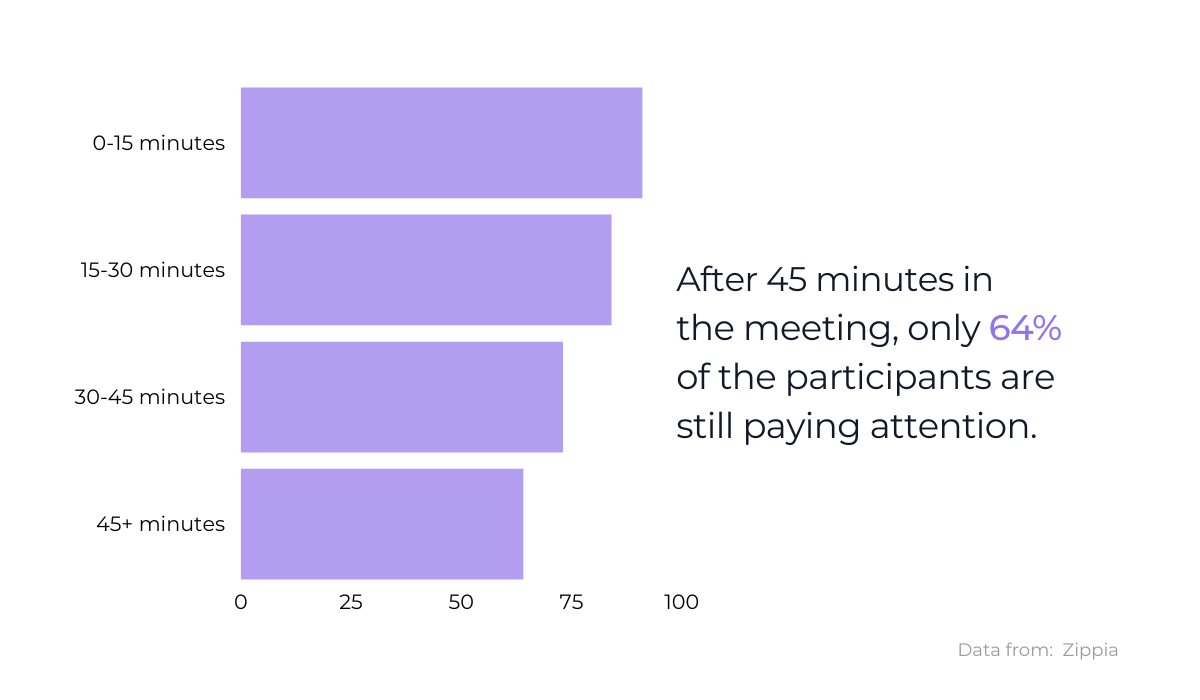
The fact of the matter is, however, that there are certain types of meetings where 15 to 30 minutes simply isn’t enough time to cover everything.
Project kickoff meetings tend to fall into this category.
There is a lot that needs to be discussed in a project kickoff meeting—from determining the project’s purpose to discussing the details of its scope and assigning project roles and responsibilities.

Get unreal data to fix real issues in your app & web.
Addressing these topics early on is essential for the success of the project, and it is not advisable to just gloss over them in 15 minutes.
So, how much time should you set aside for a project kickoff meeting? Adrian Neumeyer, the founder and CEO of Tactical Project Manager, shares his experience:
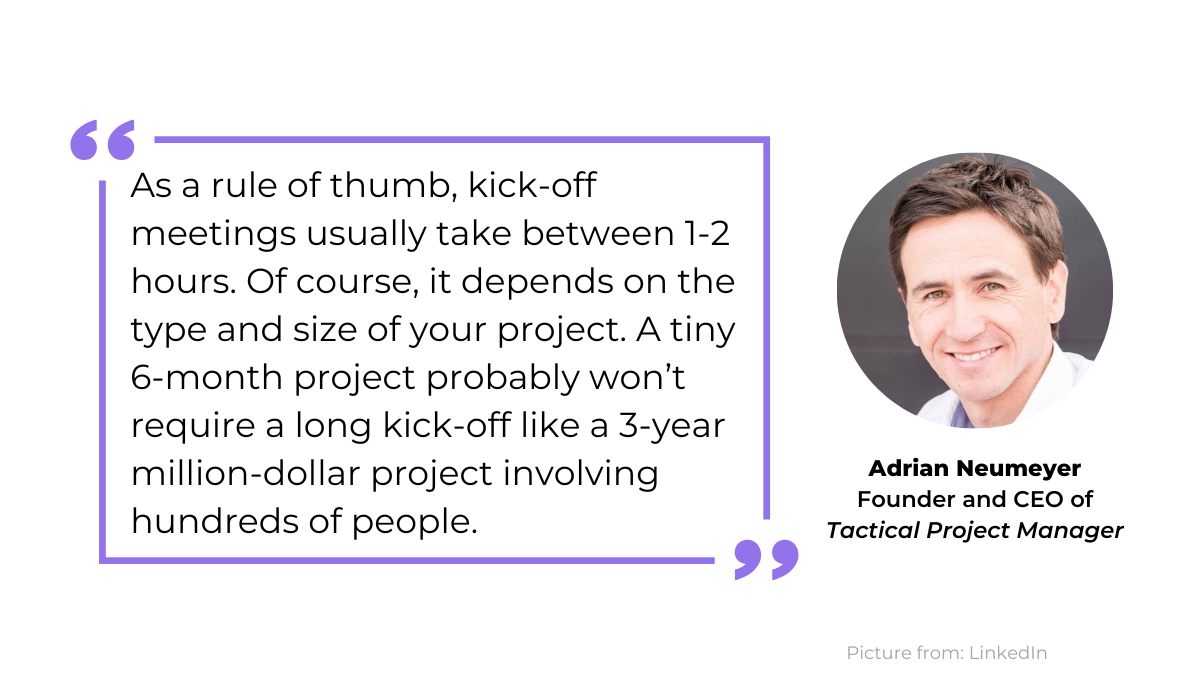
Neumeyer’s experience goes to show that there are no firm rules.
He goes on to explain that he would allot about two hours for a kickoff meeting regarding an IT project that would take one year to complete.
At TXI, a digital strategy and product innovation firm, they take a completely different approach—their project kickoff meetings span over the course of two days.
Although their approach is time-consuming and requires a lot of effort and focus, the benefits outweigh the drawbacks.
Taking two full days to discuss everything project-related gives the TXI team plenty of time to agree on the scope of the project, determine the risks and discuss the costs.
By getting on the same page with the client early on, they are preventing issues from appearing down the line.
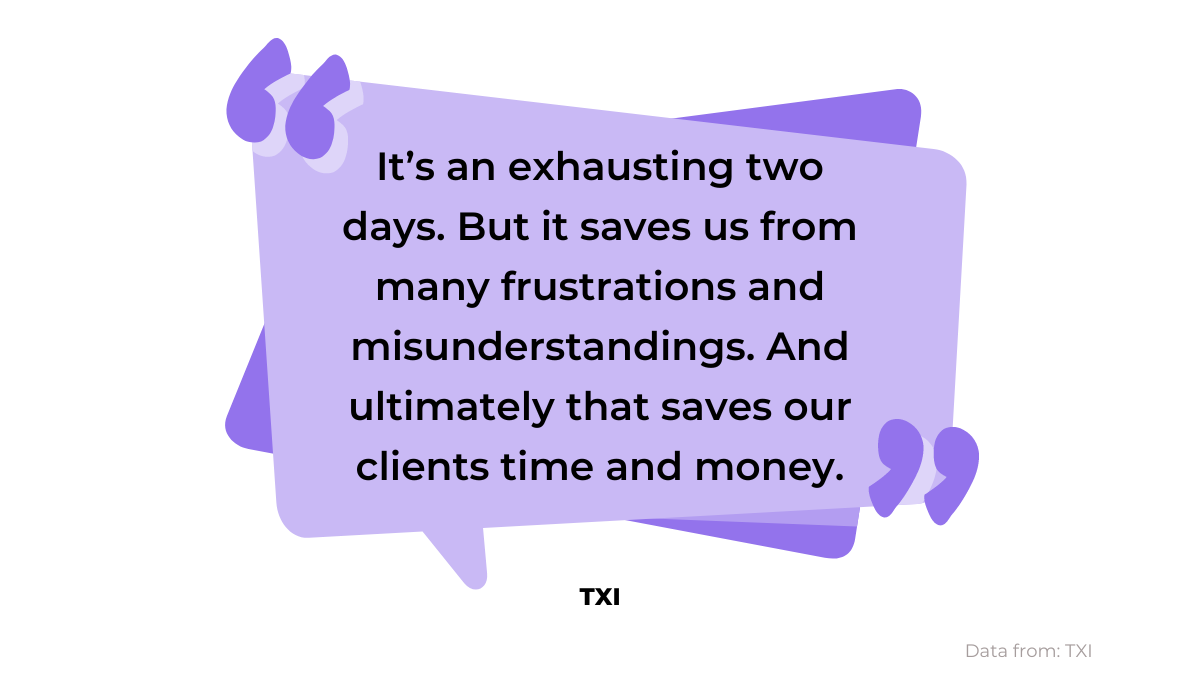
So, how can you decide what the optimal project kickoff meeting duration is? The answer is that there is no universal answer, as the duration is going to vary from project to project.
What can help you with determining the needed length of the meeting, however, is a well-thought-out meeting agenda.
Prior to the kickoff meeting, determine what topics you need to discuss in order for the meeting to serve its purpose.
Make sure to allocate plenty of time for each topic, plus some extra time at the end of the meeting for questions.
Taking some time to answer your team’s questions can save you from misunderstandings and errors later on.
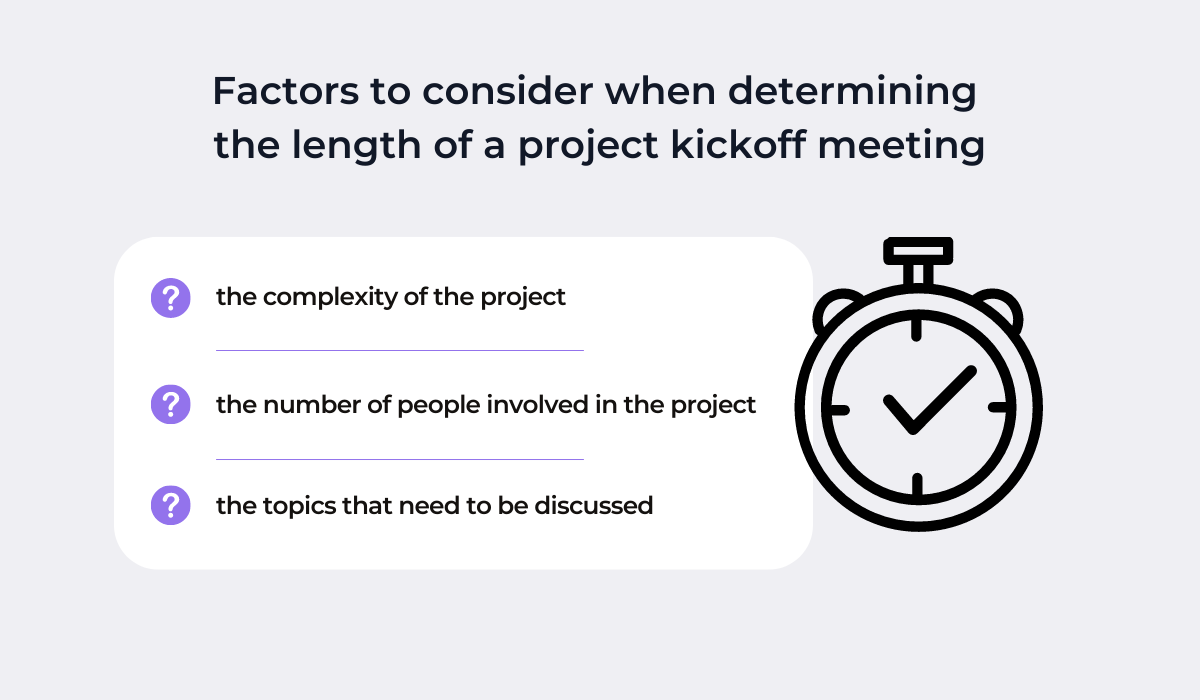
Determining how long your project kickoff meeting should be can be a challenge.
You need to make sure the meeting is long enough to cover all relevant topics, but not so long that your team loses focus and stops paying attention.
Accomplishing this balance isn’t easy, so don’t feel bad if you don’t get it right on the first try. With time and experience, you will eventually find out what works best for you and your team.
Let the participants get to know each other
Given that each new project is going to require your team to work together with the client and their team, it is essential to ensure that everyone involved gets to know each other.
While it is useful for each participant in the meeting to know what roles others will be taking on during the project, this isn’t enough.
After all, both teams are going to be required to collaborate for an extended period of time, so just knowing each other’s names and job titles isn’t likely to help them develop a closer working relationship.
Dr. Mahreen Khan, a senior researcher at Atlassian, explains that cohesion is key for effective teams, and suggests using icebreaker activities in order to get team members to bond.
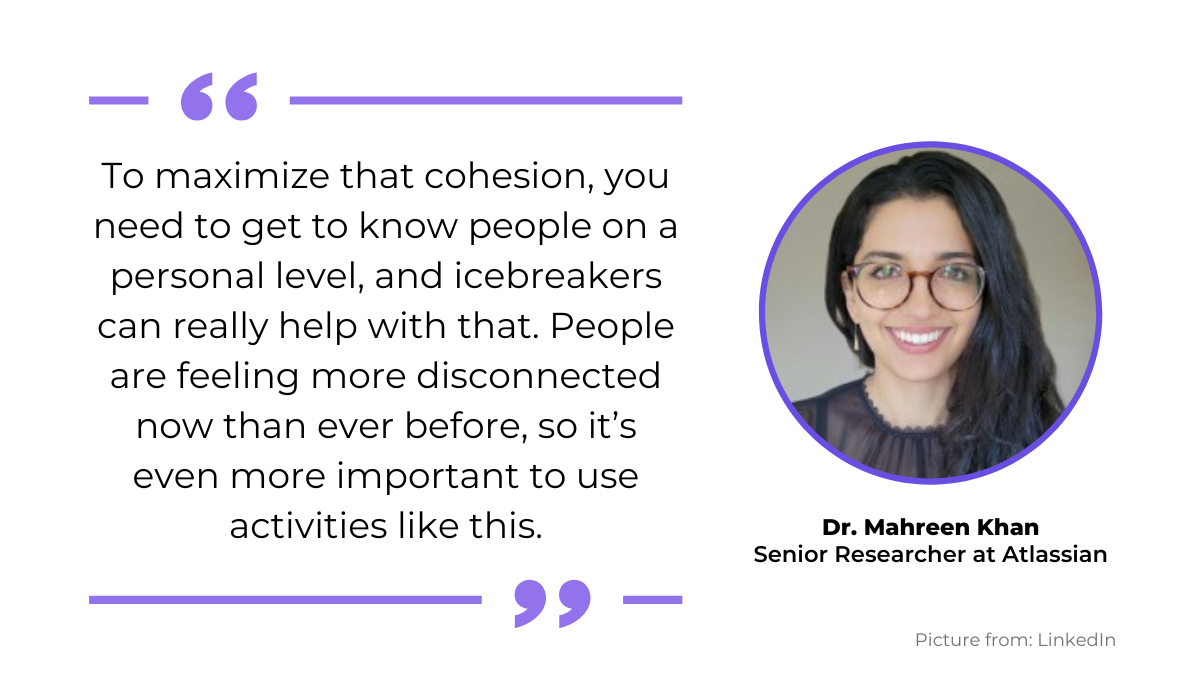
Effective collaboration and exchange of ideas are crucial for the success of the project. In order to achieve that, however, all participants need to feel comfortable working together.
According to studies, employers and employees are aware of the importance of collaboration.

In order to achieve better alignment within your team, encourage your team members to get to know each other on a more personal level by implementing a short icebreaker session at the beginning of the meeting.
Episode 6 of The World of Work Podcast provides valuable insight into the importance of bringing teams together with the help of icebreakers.
James Carrier and Jane Stewart, the creators of The World of Work Project, explain that icebreakers break down social barriers, making it easier for individuals to interact with each other.
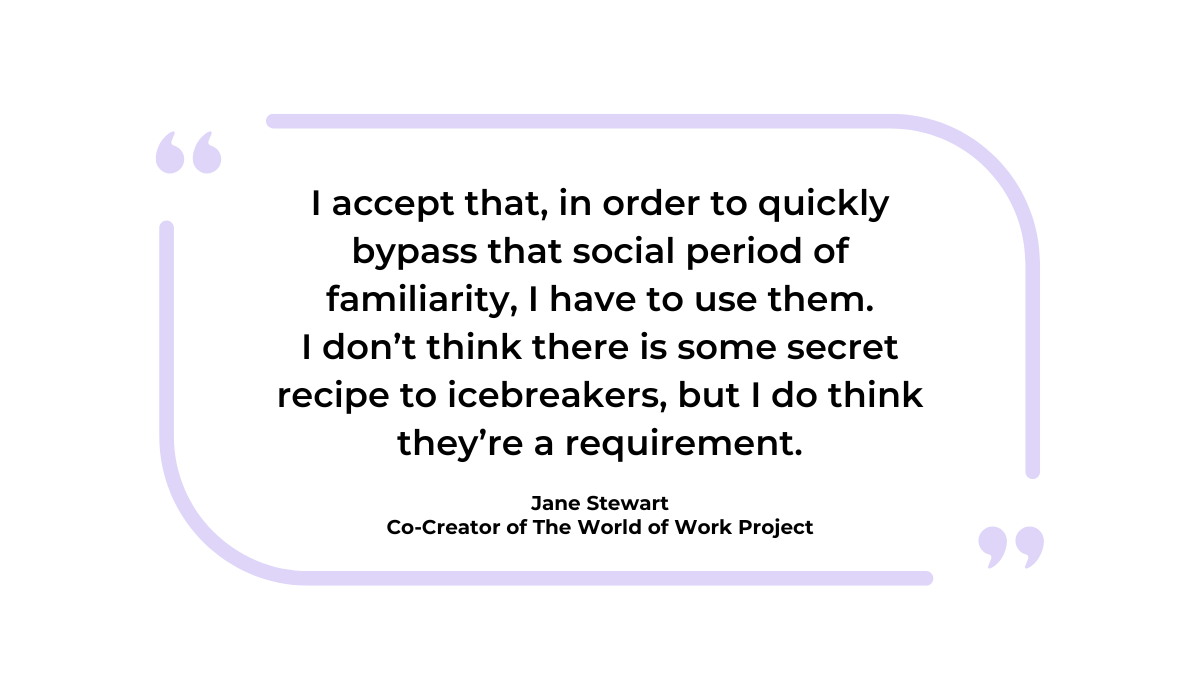
Even though some people might view them as a necessary evil, Carrier and Stewart agree that icebreaker activities are extremely beneficial in settings where new teams are required to work together.
If you look up “icebreakers for meetings”, you will find a plethora of ideas to choose from. However, the one icebreaker game that you can’t go wrong with is Two Truths and a Lie.
The principle is simple: you go around the room and have each meeting participant make three statements about themselves – two true and one false – while the rest of the group is tasked with figuring out which one they believe is a lie.
This game has proven to be a success for Slido, an audience interaction platform.

At Slido, they have the habit of welcoming new employees by playing this game because it allows them to share facts about themselves in a fun and interactive way.
Think about incorporating a game of Two Truths and a Lie at the beginning of your next kickoff.
It will give you an opportunity to learn about the people your team will be working closely with while creating a comfortable atmosphere.
Clearly communicate expectations
In order for your kickoff meeting to be productive, you want to ensure that everyone involved in the project is on the same page about what needs to be accomplished.
You can achieve that by setting clear project expectations.
A Gallup survey has uncovered that about 50% of the respondents don’t know what exactly is expected of them at work.
Furthermore, their 2022 State of the Global Workplace Report shows that only 21% of employees on a global level are engaged while working.
So, what can you do to ensure that your project team doesn’t become a part of these numbers?
Let’s take a look at the key drivers of employee engagement, i.e., what it is that employees need in order to be engaged in the workplace:
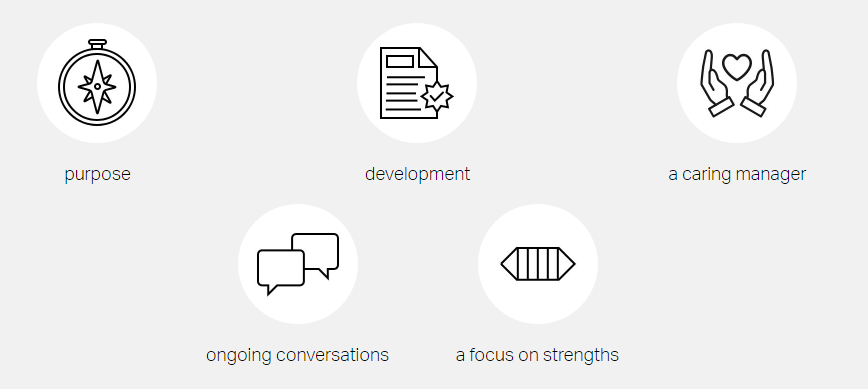
Employee engagement is directly correlated to the employees’ understanding of their purpose, i.e., the value of what they are doing.
Furthermore, they appreciate ongoing communication, as it helps them understand what they are expected to do.
In order to be able to actively participate in the project, your team members need you to openly communicate your expectations of them.
The importance of communication for setting expectations isn’t a new concept, though.
Alex Lieberman, Executive Chairman and co-founder of Morning Brew took to Twitter to share some of the lessons he learned from Amazon’s 1997 shareholder letter.
One of them highlights the importance of setting expectations:

Apart from setting expectations, it is important to make meeting them easier for your team members, too.
You can achieve that by taking into account their strengths when delegating tasks. Nan Crawford, CEO of Nan Crawford & Co., explains:

Being familiar with the fortes of individual team members will help you assign tasks in an optimal way. After all, you want to make sure that the results they are delivering are high-quality.
Here’s the takeaway. One of the best ways to set clear project expectations is through open communication.
Use the project kickoff meeting as an opportunity to be proactive and assign roles and responsibilities early on and based on individual team members’ strong points.
That way, you are making sure that there is no confusion about who is expected to do what later down the line.
Allow unrestricted access to information
Now that we’ve explained the importance of being clear about project expectations, it is time to discuss how you can help your team meet them to the best of their ability.
The answer is pretty straightforward—they need unrestricted access to relevant project information.
You might feel like that sounds unrealistic—after all, there are certain types of information that are generally restricted due to legal requirements, and the client might not feel comfortable sharing them with your entire team.
Use the project kickoff meeting as an opportunity to have an open conversation with the client about the importance of giving your team access to all relevant project documentation.
Clarify that, in order to be able to put their best foot forward, your team members need to understand the ins and outs of the project.
This won’t be possible if only a small part of the project-related information is available to them.
Michael Pressey, a website developer at Exquisite Media, explains that requiring your project team to deliver good results without ensuring transparency is likely to negatively affect the project.
He goes on to state that restricted access to information can slow down project delivery, thus increasing project costs.

Of course, not every client might feel comfortable sharing unrestricted access with every single project contributor.
In such cases, Pressey recommends giving the project manager full access and the permission to share that access with team members that need it.
That being said, access to information isn’t only important for the team members to be able to carry out the tasks they have been assigned. It is also necessary for proper collaboration.
Let’s say you have several team members working on the same task, but only one of them has insight into the relevant project documentation.
It won’t be possible for them to move on to the next phase until the other team members are also granted access so that they can do their part.
Such situations may cause your team members to feel like they aren’t worthy of trust.
This lack of trust is not only frustrating for the employee, but can also be harmful to the organization. Let’s see how:
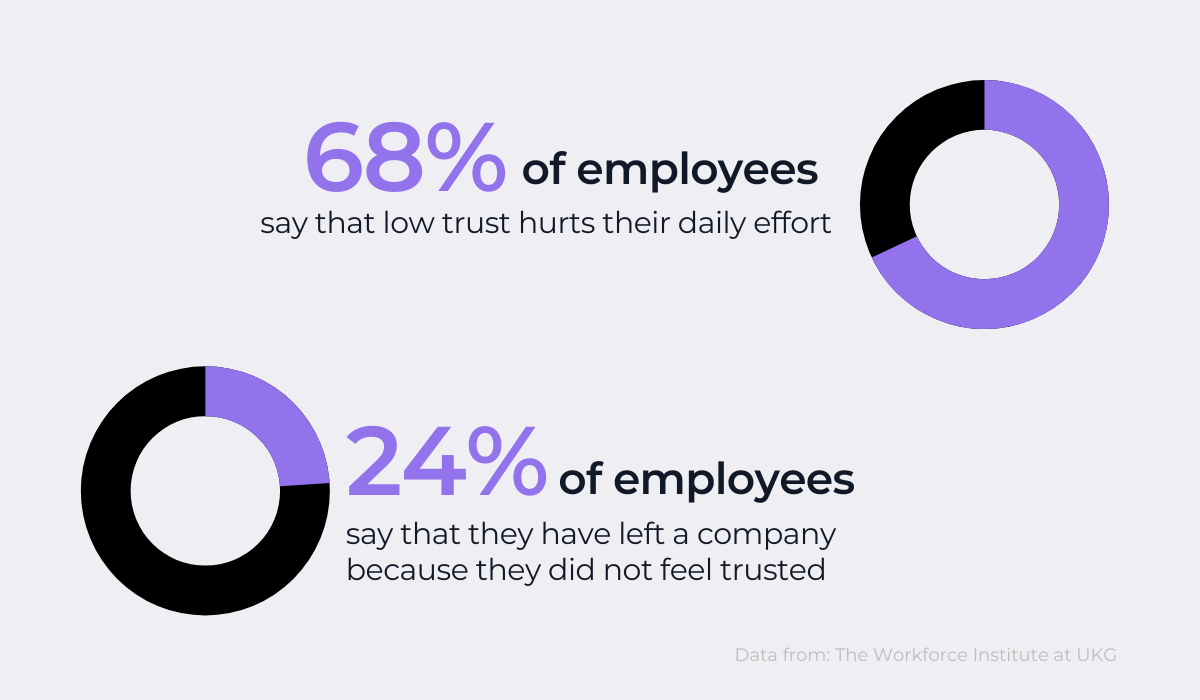
The results of research conducted by The Workforce Institute corroborate the idea that employees largely don’t perform to their full potential when they don’t feel like their superiors trust them.
Katie Bardaro, SVP of Customer Experience at Syndio, commented on the findings in the PayScale report entitled You’re Not The Boss Of Me: Trust In The Workplace.
Bardaro believes that there is a strong connection between trust and creating productive professional relationships.

As a manager, you have the ability to vouch for your team at the kickoff meeting and advocate for giving them unrestricted access to project-related information.
Being able to consult relevant resources is crucial for facilitating collaboration and coordination within your project team.
The easiest way to share and organize project information is with the help of project management software.
Given that there is a plethora of options available, you need to do meticulous research in order to find the one that is the right fit for you and your team.
One of the most popular project management solutions at the moment is ClickUp.

Apart from being praised for having a competitive price, being highly customizable, and allowing integrations with hundreds of other tools, ClickUp prides itself on prioritizing the security of its clients’ data.
The right project management software can help you share project information with your team while maintaining a high level of security at the same time.
If you encounter pushback from stakeholders regarding the level of access to the information your team should have, consider explaining the drawbacks of limiting their access.
Conclusion
Making your project kickoff meeting productive is key to the success of your project.
This meeting between your team and the client is going to set the tone for what is to come, so you want to make sure to get the most out of it.
There is a lot to be discussed in the kickoff meeting, so create a thorough agenda and give yourself enough time to cover all relevant topics.
Make sure to allocate some time at the beginning of the meeting for a quick icebreaker session – this will help everyone involved get to know each other on a personal level, thus making collaboration easier.
If you want your project to run smoothly, don’t underestimate the importance of openly communicating project expectations to your team and providing them with the resources to do their best work.





